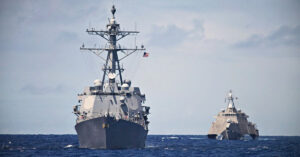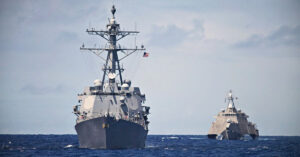
Ukrainian Navy Destroys Russian Offshore Gas Platform Used For GPS Spoofing In Black Sea
August 12, 2024
U.S. Coast Guard Spots Russian Naval Vessel Near Alaska’s Aleutian Islands
August 12, 2024

The U.S. Navy is encountering its worst shipbuilding crisis, lagging far behind China in production due to severe labour shortages, cost overruns, and continuous design modifications.
Despite efforts to overcome these challenges, the Navy’s shipbuilding capability remains extremely limited.
Marinette Marine, a prominent shipbuilder in Wisconsin, is currently under contract to build six guided missile frigates and has an option to build four more.
However, due to staff limitations, it can only build one frigate per year. The company’s issues reflect the broader shipbuilding industry challenges, such as labour shortages and increasing production costs.
Eric Labs, a naval analyst at the Congressional Budget Office, stated that there isn’t any quick or easy way to get out of this situation as it took them a lot of time to get into it, describing the situation as a terrible state.
Lucas Andreini, a welder at Marinette Marine, is a well-known example of someone who transitioned from manufacturing garbage truck parts to working on Navy frigates.
Andreini’s inspiring story highlights the ongoing efforts to train and retain a new generation of shipbuilders through programs at technical colleges and employer-sponsored training.
Despite these initiatives, recruiting and keeping skilled workers remains a major challenge.
Navy Secretary Carlos Del Toro emphasized the necessity of such training programs, particularly those in collaboration with community colleges and shipyards like the Portsmouth Naval Shipyard. These programs aim to provide workers with the necessary skills for shipbuilding and maintenance, including specialized training for nuclear submarine repairs.
In response to the workforce crisis, the U.S. Navy has allocated $100 million to Marinette Marine, with up to $10,000 of it going for retention bonuses. The initiative is intended to address the shipyard’s high turnover rates, which have affected nearly 2,000 workers.
Regular changes in ship design requirements have made the Navy’s issues worse, leading to higher costs and further delays. The redesign of 85% of the new frigates, expected to speed up production and reduce costs, has instead led to increased expenses and delayed delivery dates.
The first frigate, the Constellation, is now scheduled to be delivered in 2029, three years later than previously intended.
According to the US Office of Naval Intelligence, China’s naval production capacity greatly outpaces that of the United States, with ships being produced 200 times faster.
Shipyard consolidation and funding uncertainty have also disrupted the shipbuilding cycle, affecting long-term planning and investment.
Matthew Paxton of the Shipbuilders Council of America stated that inconsistent shipbuilding plans have increased labour shortages.
Despite these challenges, the US Navy is committed to finding innovative solutions. Lt. Kyle Hanton, a representative for Del Toro’s office, stated that the Navy’s responsibility in safeguarding the nation and maintaining peace has never been stronger.
Reference: FirstPost, NYPost
U.S. Navy Faces Worst Shipbuilding Struggles In 25 Years Due To Labor Shortages & Rising Costs appeared first on Marine Insight – The Maritime Industry Guide
Source: Maritime Shipping News


